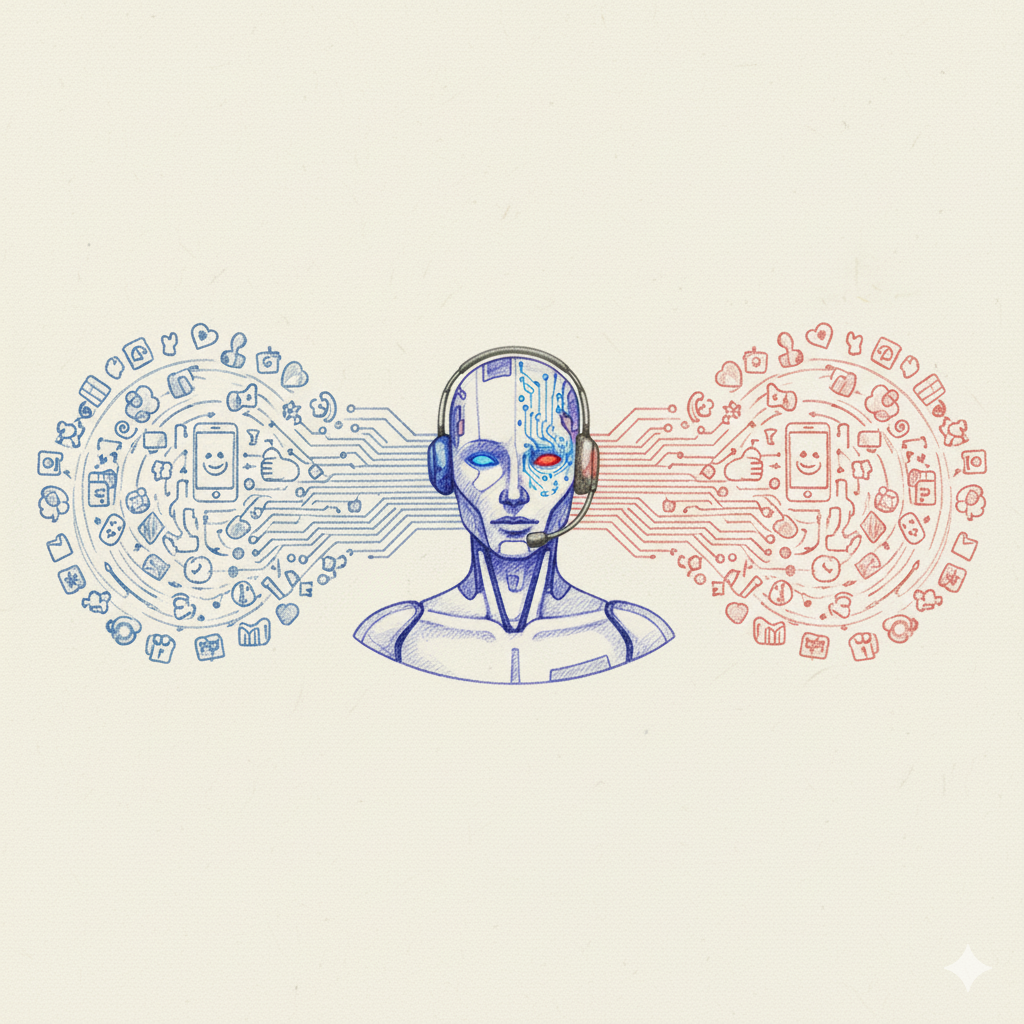Product Strategy Consulting for Modern Growth
Discover how modern product strategy consulting drives real business growth. Learn to build winning strategies and leverage AI for a competitive edge.
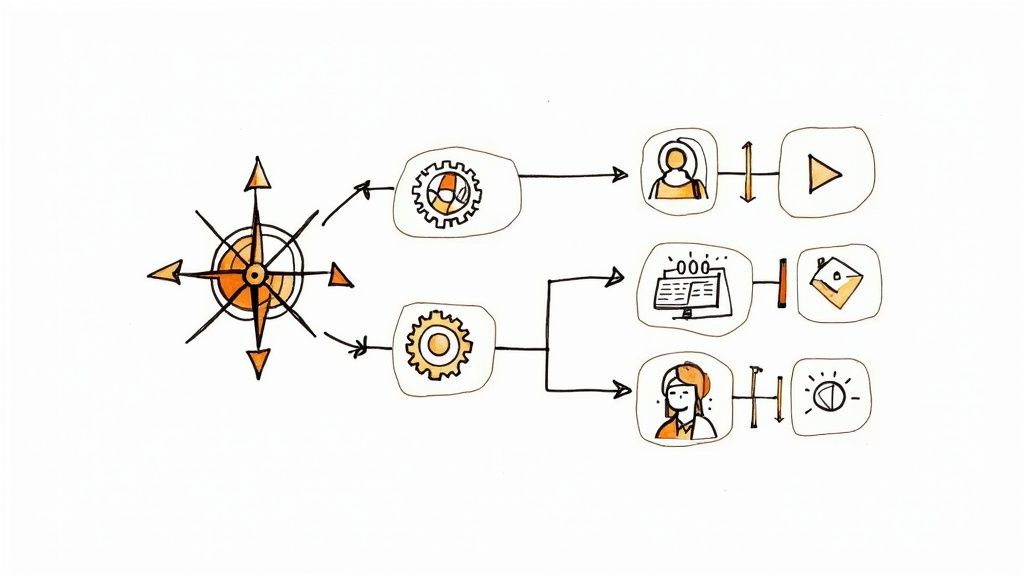
In a market that moves at lightning speed, simply having a great product isn't enough to guarantee success. You need a killer game plan, a clear path from where you are to where you want to be. This is exactly where product strategy consulting enters the picture. Think of it as bringing in a seasoned navigator to map out your route to market leadership, ensuring your product doesn't just exist but truly connects with what your customers are looking for.
Why Product Strategy Consulting Matters Now More Than Ever
So many business leaders feel the constant pressure to innovate, but innovation without a clear direction is a fast track to wasted resources. Product strategy consulting provides that essential focus. It brings an objective, outside-in perspective that internal teams—often too close to the project to see the bigger picture—can easily miss. A consultant's job is to close the gap between your ambitious business goals and the hard realities of the market.
This isn't about admitting you don't have the answers. It's a strategic move to gain a real competitive edge. Bringing in an expert gives you fresh eyes to challenge long-held assumptions and ensures your product roadmap is not only ambitious but also practical and perfectly aligned with what people actually want to buy.
Gaining an Unbiased External Viewpoint
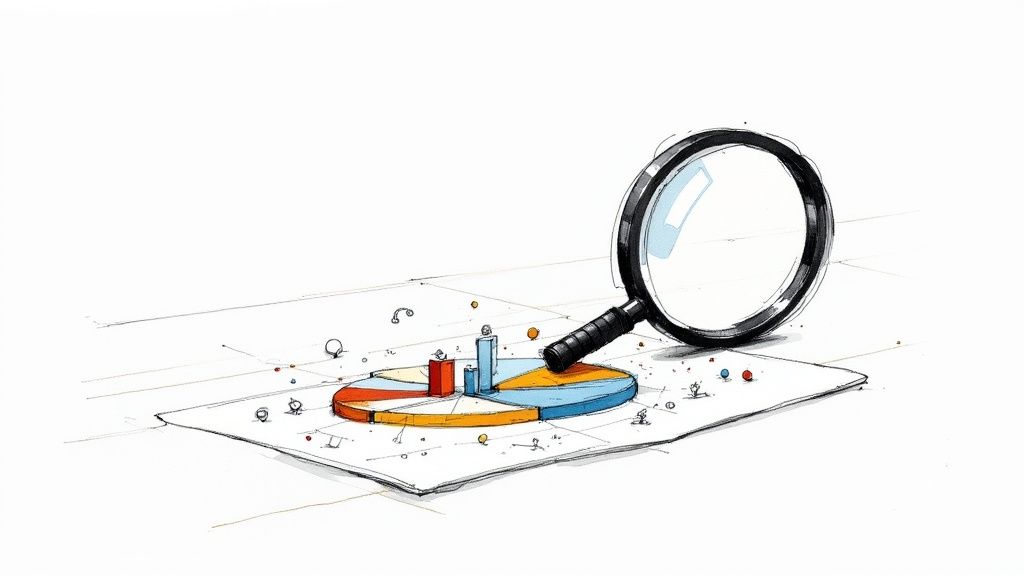
Let's be honest, internal teams can develop blind spots. They're shaped by company culture, past projects, and internal politics. A consultant, on the other hand, comes in as a neutral third party, free from all that baggage. This unique position allows them to:
Uncover hidden opportunities your team might have overlooked.
Flag potential risks before they snowball into expensive headaches.
Give a brutally honest assessment of your product’s real strengths and weaknesses.
This impartial analysis is the bedrock of a strategy built on solid ground, not just internal wishful thinking. It’s a crucial element of effective AI strategy consulting, where an objective view makes certain that technology genuinely serves business goals.
The rising value of this expertise is clear in market data. Germany, Europe's consulting powerhouse, sees companies relying more and more on consultants to navigate digital transformation. The wider European consulting services market, which includes product strategy, was valued at USD 4.3 billion and is forecast to hit USD 5.6 billion by 2032. This shows just how vital consulting has become for driving smart decisions in today's complex business world. You can find more details on European consulting market trends from Verified Market Research.
Beyond Advice to Actionable Plans
Truly effective product strategy consulting doesn't stop at high-level advice; it delivers concrete, actionable plans. Consultants aren't just thinkers—they're builders who turn deep insights into a coherent strategy you can actually execute. This means defining a sharp product vision, setting goals you can measure, and creating a roadmap that's grounded in reality.
A great product strategy doesn’t just tell you what to build; it tells you what not to build. It provides the focus needed to allocate resources effectively and say 'no' to distractions that pull you off course.
This disciplined focus is essential, whether you're a startup or a global corporation. For startups, it’s key to securing funding and finding that elusive product-market fit. For established companies, it makes sure new products align with the overall corporate vision and deliver a solid return on investment. Our philosophy for AI co creation is built on this very principle, ensuring every strategic move is collaborative and focused on results. The guidance from our expert team is what turns a strategic idea into a market success.
The Building Blocks of a Winning Product Strategy
A great product strategy isn't just some document you write once and file away. Think of it as a living, breathing guide that informs every single decision, from the big-picture vision right down to what the development team works on today. It's the blueprint for success, making sure everyone is pulling in the same direction. Without it, even the most brilliant product idea can end up lost at sea in a crowded market.
At its heart, product strategy is all about making tough, deliberate choices. It clearly answers: what will this product do, who is it for, and how will it beat the competition? This focus stops teams from getting distracted by shiny new trends or building features that don't really move the needle—a common trap that burns through time and money.
A truly effective strategy is the bridge connecting your company's high-level business goals to the product you're actually building. It ensures your product is more than just a random assortment of features; it's a powerful engine for hitting specific business targets.
Deep Market and Customer Understanding
The first, non-negotiable pillar of any solid strategy is getting to know your market and customers inside and out. This means going way beyond basic demographics. You have to roll up your sleeves and dig deep to uncover the real needs, frustrations, and unspoken wants of your target audience. Any worthwhile product strategy consulting always starts right here.
Market Analysis: This is about sizing up the playing field. How big is the market? Is it growing? Are there any tech shifts or new trends creating opportunities or threats? This helps you figure out where you can compete and win.
Customer Segmentation: Let's face it, not all customers are the same. This process involves grouping your audience into smaller, distinct segments based on what they do, what they need, and what drives them. This lets you tailor your product much more effectively.
Competitive Landscape: You absolutely have to know who you're up against. A thorough analysis of your competitors—their strengths, weaknesses, products, and market position—is critical for spotting gaps you can fill and defending against their moves.
You can only start building a strategy that resonates and holds up under pressure once you have this foundational knowledge. It’s all about swapping out assumptions for hard evidence.
A Compelling and Unique Value Proposition
Once you have a firm grasp of the market, you need to nail down your unique value proposition. This is a simple, clear statement that answers three questions: how does your product solve a customer's problem, what makes it different from everything else out there, and what specific benefits will they get?
A strong value proposition is the heart of your product strategy. It is the promise you make to your customers and the reason they should choose you over anyone else.
Think of it as your product's "superpower." Is it faster? Cheaper? Easier to use? Does it have a game-changing feature nobody else offers? Whatever it is, this unique edge has to be something your customers genuinely care about—and are willing to open their wallets for. Without a clear differentiator, your product is just another face in the crowd, likely forced into a race to the bottom on price.
An Agile and Realistic Product Roadmap
The final piece of the puzzle is the product roadmap. This is where your strategy gets real and turns into an actionable plan. A roadmap isn't a rigid, feature-by-feature timeline set in stone. It’s a strategic communication tool that lays out the development priorities and direction over time.
A good roadmap should:
Be outcome-focused: It should prioritise work that delivers real customer value and business results, not just a laundry list of features.
Reflect strategic goals: Every single item on the roadmap should have a clear line back to the overall product vision and strategy.
Remain flexible: Markets shift, customer needs change, and new opportunities pop up. A great roadmap is a living document that can adapt to new information without losing its strategic north star.
Putting all these pieces together into a cohesive plan is a serious challenge. For those looking to build their own models, you can explore how to create a foundational guide with our AI strategy framework. This structure helps ensure your product’s journey is guided by clear thinking, not just a series of disconnected tasks.
How AI Is Reshaping Product Strategy
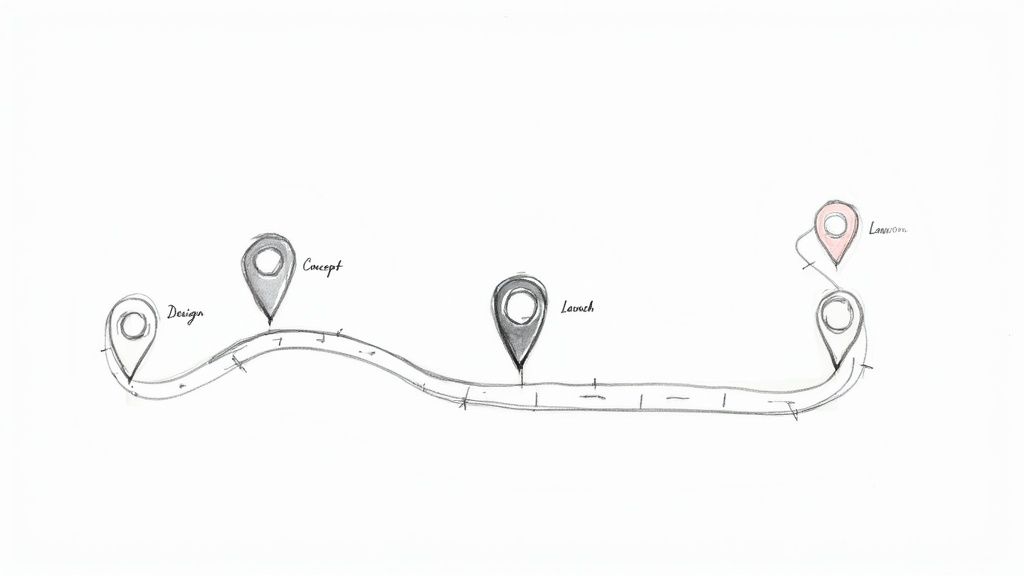
Artificial intelligence isn't some far-off concept from a sci-fi movie anymore. It's here, and it’s fundamentally changing how businesses build their product strategies. For years, strategists had to lean on historical data and their own gut feelings. AI injects a whole new level of speed and precision into that process, moving product strategy consulting from the world of educated guesses to one of data-driven confidence.
Think of it like this: trying to create a strategy without AI is like navigating the open ocean with an old paper map and a compass. You’ll probably get where you’re going, but it will be a slow, uncertain journey. AI is your upgrade to a modern GPS. It doesn't just show you where you are; it analyses weather patterns, ocean currents, and other ships to chart the fastest and safest course in real-time.
It's important to realise this is about making human intelligence better, not replacing it. Our entire approach to AI co creation is built on that very idea. The AI does the heavy lifting—the tedious data crunching—which frees up your team to do what they do best: creative problem-solving and making smart strategic decisions. It’s a partnership that turns massive, messy datasets into a real competitive edge.
From Big Data to Smart Decisions
One of the biggest headaches in strategy has always been the sheer amount of information you have to deal with. You've got customer feedback, sales reports, social media chatter, and competitor moves all coming at you at once. It’s a tidal wave of data, and no human team can possibly sift through it all.
This is exactly where AI shines. It can dig through those mountains of information to find the golden nuggets of insight. Modern AI strategy consulting uses machine learning to:
Analyse market trends as they happen: AI can watch thousands of sources at once, spotting new trends or shifts in customer behaviour long before they become obvious to the naked eye.
Find hidden patterns: It's brilliant at connecting the dots in ways humans can't, revealing unmet needs or brand-new market opportunities.
Create laser-focused customer segments: Forget broad demographics. AI can group customers into tiny micro-segments based on their actual behaviour, paving the way for truly personalised products and marketing.
This capability completely changes how we see the market. Instead of just reacting to what happened last quarter, businesses can start to anticipate what customers will want next and build products that meet them there.
Accelerating the Strategy Cycle
Developing a product strategy the old-fashioned way is a long slog. It often takes months of workshops, manual research, and back-and-forth debates. That slow pace can be a killer in a market that changes by the week.
AI slams the accelerator on this entire cycle, without cutting corners on quality.
AI-powered tools can condense months of analytical work into a matter of hours. This gives businesses an agility to tweak and refine their strategy that was simply impossible before. Speed isn’t just about efficiency; it's a powerful strategic weapon.
For example, our AI Strategy consulting tool can generate solid, data-backed strategic hypotheses right from the start, just by using your business inputs and market data. This gives your team a strong foundation to build on, so they can spend their valuable time refining and testing the strategy, not starting from a blank page. Even the initial discovery phase gets a boost. Tools like our AI requirements analysis generator can synthesise input from all your stakeholders and user needs, turning a complex mess into a clear, efficient starting point.
What does this mean for you? You can adapt to market shifts faster, launch new products with more confidence, and jump on opportunities before your competitors even see them coming.
Proving Concepts with Real-World Data
This isn't just theory; the impact of AI on product strategy is being proven every day in just about every industry. To see exactly how these ideas work in the real world, you can browse our library of real-world use cases. These examples show how companies are using AI to take the risk out of new product launches, fine-tune their pricing, and achieve a much stronger product-market fit.
As we explored in our AI adoption guide, the trick is to weave AI into your strategic framework in a thoughtful way. A solid AI strategy framework makes sure the technology is always serving your bigger business goals. At the end of the day, the goal of product strategy consulting has always been to deliver a winning plan. With AI, that plan is now built on a foundation of data, speed, and insight that we’ve never had before. The experts on our expert team specialise in turning these tech capabilities into real business results.
How a Product Strategy Consulting Engagement Actually Unfolds
So, what really happens when you bring a product strategy consultant on board? It can feel a bit like a black box, but the process is actually a very structured journey. Forget about a one-off meeting; think of it as a partnership that moves from understanding your world to creating a concrete, workable plan.
It all starts with a deep dive. A good consultant doesn’t just skim the surface; they immerse themselves in your business. They want to understand your goals, your daily operational hurdles, and where you stand in the market. This isn't about ticking boxes; it's about building a solid foundation so the final strategy feels like it was made for you, not pulled from a generic template.
Right from the get-go, it’s a team effort. The best results come when the consultant’s outside perspective meets your team's insider knowledge. It’s this blend that turns good ideas into genuinely brilliant, executable strategies.
The Discovery and Assessment Phase
The first stage, Discovery and Assessment, is the most important one. Get this wrong, and everything that follows will be built on shaky ground. Here, the consultant goes into full information-gathering mode. This means workshops, interviews with key people across the business, and digging into all your existing data—from sales reports to customer support tickets. The aim is to get a complete, 360-degree picture of where things stand today.
One of the biggest challenges here is taking all that information and finding the real story within it. Modern tools have made this part of the job much faster. For instance, our AI requirements analysis generator can quickly sort through input from all sorts of stakeholders. What used to take ages of manual work can now become an efficient, data-rich starting point for the whole project.
This initial flow is all about getting the right people aligned on the same objectives.
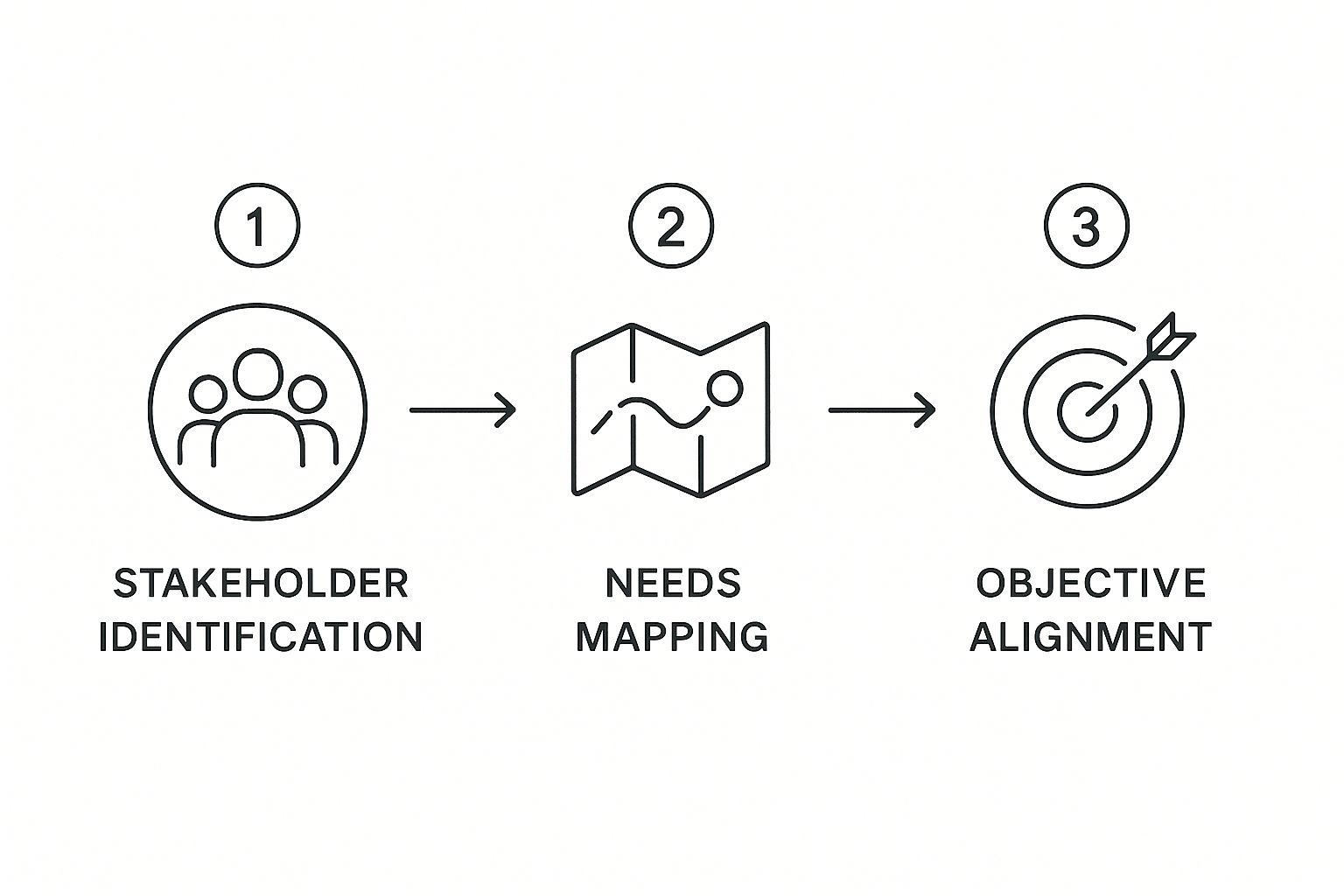
As the graphic shows, a winning strategy kicks off by identifying the key players, getting to grips with what they need, and pointing everyone in the same direction.
The main takeaway from this phase is a detailed diagnostic report. This document clearly lays out your product's strengths, weaknesses, opportunities, and threats (a classic SWOT analysis) and offers an early hypothesis for the strategic path forward. It makes sure everyone is on the same page before any big decisions are made.
Strategy Formulation and Roadmap Development
Once everyone agrees on the current state of play, the project moves into Strategy Formulation. This is where the real magic happens, turning all those insights into a solid plan. Working hand-in-hand with your leadership, the consultant helps define a crystal-clear product vision, sets goals you can actually measure, and crafts a value proposition that makes you stand out.
This stage is incredibly collaborative. A consultant shouldn't just vanish for a few weeks and come back with a polished PowerPoint. It’s a series of workshops and co-creation sessions where strategic ideas are tested, debated, and refined together. This approach is central to our philosophy of AI co-creation and is crucial for getting your team to truly buy into and own the final plan.
At the end of this stage, you’ll have:
A formal product strategy document.
A prioritised product roadmap showing the key initiatives and timelines.
A clear set of Key Performance Indicators (KPIs) to track success.
Implementation Support and Continuous Optimisation
The final piece of the puzzle is Implementation Support. After all, a brilliant strategy is worthless if it just sits on a shelf. The consultant’s role now changes from strategist to coach. They’ll work alongside your product and development teams to help turn the roadmap into reality, guiding them through early obstacles and keeping the momentum going.
This ongoing support is vital. It ensures the strategy isn't a rigid document but a living guide that can adapt as you get new feedback from the market or as business priorities shift. This hands-on approach reflects a bigger trend in Germany's consulting market, which has ballooned to an estimated €47.7 billion by focusing on practical results and digital know-how. As German companies deal with complex regulations and the new normal of remote work, the need for practical, expert guidance has never been higher, a trend detailed in IBISWorld's industry report.
When all is said and done, a great consulting engagement gives you more than just a plan. It leaves you with an energised team and the in-house strategic muscle to drive long-term growth. The experts on our team are dedicated to making sure this journey delivers real, lasting value.
Overcoming Common Product Strategy Pitfalls
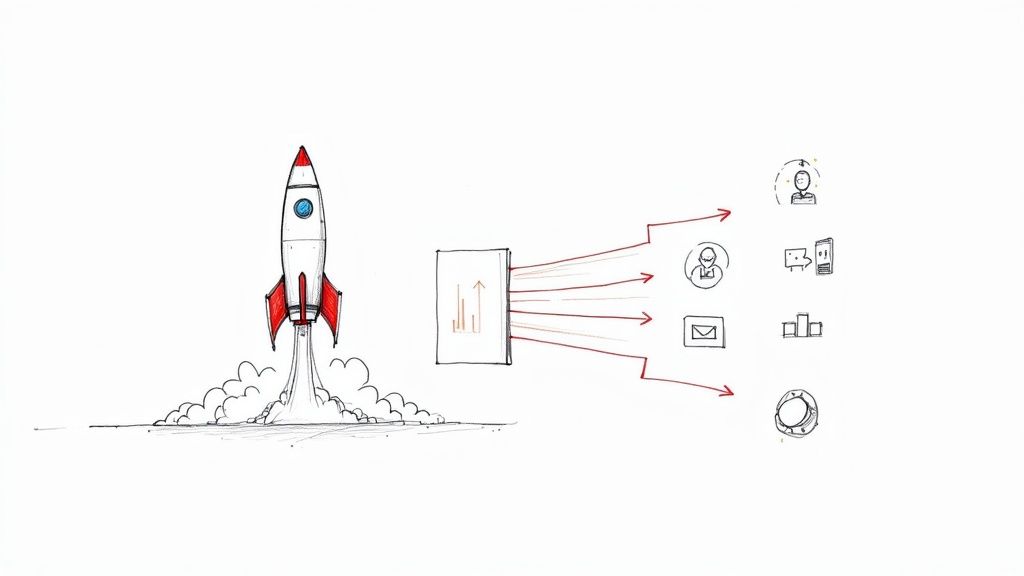
Even the most brilliant product strategy will hit a few bumps on the road to launch. Getting a product out the door is never a straight line; it's a messy, challenging journey. The trick is to anticipate the common roadblocks before they derail your progress.
From internal squabbles to completely misreading what customers actually want, the path is full of potential traps. This is where product strategy consulting really proves its worth. It’s not just about creating a plan, but about having the foresight to see these pitfalls coming and giving your team the tools to navigate around them.
When you know what to look out for, you can build a more resilient strategy from day one. Let's dig into a few of the most common hurdles and how you can clear them.
Analysis Paralysis and Scope Creep
Ever been in a meeting where everyone is so bogged down in data and what-ifs that no decision ever gets made? That’s analysis paralysis, and it’s a classic product management trap. Teams can get stuck debating features and researching competitors for so long that they miss their chance to actually build something.
This often leads directly to its evil twin, scope creep, where the list of "must-have" features grows and grows until the original vision is completely lost.
To get out of this cycle, you need discipline.
Set a "North Star": Agree on one single, overarching metric that guides every decision. This cuts through the noise and keeps everyone pointed in the same direction.
Timebox your research: Give the discovery and analysis phases a hard deadline. This forces the team to switch from endless thinking to decisive action.
Be ruthless with prioritisation: Use a simple roadmap like Now-Next-Later. It forces you to focus on what delivers immediate value, not on a bottomless backlog of ideas.
Internal Resistance and Misalignment
A perfect strategy is worthless if your own team doesn't buy into it. Internal resistance is a silent killer of great products. It often comes from deep-seated departmental silos or just a simple fear of change. When engineering, marketing, and sales are all pulling in different directions, your launch is doomed to be chaotic and ineffective.
Building consensus is just as critical as building the product. When key stakeholders help create the strategy, they own it. That sense of shared ownership is what carries a project through the tough spots.
Getting everyone aligned isn't something that just happens; you have to actively work at it. This means clear, constant communication and establishing shared goals right from the start. One of the best ways to forge this unity is through a well-run strategic alignment workshop. Bringing everyone into one room to hash things out ensures the entire team understands the vision and, just as importantly, their specific role in making it a reality.
Missing the Mark on Product-Market Fit
This is the big one—the ultimate pitfall. You build a beautiful, elegant product that absolutely nobody wants. This happens when a team falls in love with their solution before they've truly validated that it solves a real, painful problem for a specific group of people. Assuming you know what your customer needs is one of the fastest routes to failure.
To avoid this costly mistake, you have to treat every assumption like a hypothesis that needs to be proven.
Start with the problem, not the feature. Obsess over your customer's pain point before you even think about a solution.
Build a Minimum Viable Product (MVP). Create the simplest possible version of your product that can test your core idea and get you real, honest feedback from actual users.
Iterate based on data, not opinions. Use the feedback and usage metrics you collect to guide your next steps. Let the evidence lead you.
Choosing Your Ideal Product Strategy Partner
Picking the right product strategy partner is a huge decision. It’s not just a line item in your budget; it’s a choice that will shape where your product goes for years. You aren't simply hiring a vendor. You're looking for a genuine collaborator who clicks with your team and truly gets what you're trying to achieve.
The right firm won’t just hand you a generic playbook. They’ll roll up their sleeves and become an extension of your own strategic thinking, bringing deep industry know-how, a track record of real wins, and a firm grasp on modern tools—especially AI. The goal is to find a team that leaves your organisation stronger and smarter long after they’ve gone.
Core Criteria for Evaluation
When you start looking at potential partners, you need to be thorough. Get past the glossy brochures and sales pitches and dig into the real proof of their work. A top-tier firm should have no problem showing their strengths in these areas.
Deep Industry Expertise: Do they actually know your market? Someone with direct experience in your field will understand the subtle challenges and opportunities much faster, leading to advice that actually works.
A Proven Track Record: Don't be shy about asking for case studies and clear examples of their past work. Can they point to specific projects where their guidance led to tangible results, like a boost in revenue, market share, or user numbers?
Advanced Technological Capabilities: Let's be honest, AI is a must-have skill now. A partner who is on the ball will be using AI-driven tools to speed up analysis and provide insights grounded in hard data. This is a central part of modern AI strategy consulting.
Gauging Strategic Depth and Cultural Fit
Beyond the technical skills, you need a partner who fits your company’s culture. The best way to figure this out is to ask smart, direct questions that reveal how they think and work with others.
A truly valuable consultant doesn't just answer your questions; they challenge your assumptions and ask better questions themselves. This is how you uncover the insights that can take your strategy from good to great.
The German consulting market, which has ballooned to USD 38.1 billion, is a perfect example of this. It’s a major force in Europe, and its growth is driven by demand for consultants who can deliver real digital transformation, particularly in big sectors like manufacturing and tech. You can read more about Europe's strategic consulting market on Verified Market Research.
To find that perfect fit, ask about their process. What happens when they disagree with you? How do they plan to collaborate with your team every day? Nailing down these details ensures you find a partner who won’t just build a strategy, but will also help you get your entire team excited to bring it to life. The people behind the process are what make all the difference, and we invite you to meet our expert team to see the minds behind our work.
Frequently Asked Questions About Product Strategy Consulting
To finish things off, let's tackle a few of the questions we hear all the time from business leaders thinking about product strategy consulting. Getting clear on these points can help you decide on the best way forward.
How Long Does a Typical Project Take?
The honest answer is: it depends. Every project has its own complexities. That said, a typical engagement usually lands somewhere in the 8 to 16 week range.
This timeframe gives us enough room to do the job properly—from digging deep in the discovery phase and conducting thorough market research to carefully crafting the strategy and mapping out a detailed plan. It's worth noting that our AI tools can often give us a head start, especially in those early stages, by uncovering insights much faster.
Is This Service Suitable for Small Businesses or Startups?
Yes, without a doubt. In fact, for a startup or small business, a rock-solid product strategy isn't just a nice-to-have; it's a survival tool.
With limited resources, you can't afford to chase dead ends. A strong strategy brings laser focus, helping you pour your time and money into the activities that will actually move the needle. It's about validating your product-market fit early and building a foundation you can genuinely grow on.
What Is the Expected ROI?
The return on your investment in product strategy consulting comes in many forms. You'll often see a much quicker path to market, better user adoption, and a real increase in customer lifetime value.
Perhaps the biggest win is cutting down on wasted development effort. When your product is perfectly aligned with what the market actually wants, you're not just building features—you're building value. You effectively de-risk the entire venture and set yourself up for long-term profitability.
For more answers to common questions, explore our complete product strategy FAQ section.
Ready to build a data-driven strategy that delivers real results? Ekipa.ai uses its next-generation AI platform to create tailored AI strategies in a fraction of the time of traditional consulting. Meet our expert team to see how we can help you succeed. Start building your winning strategy today.


